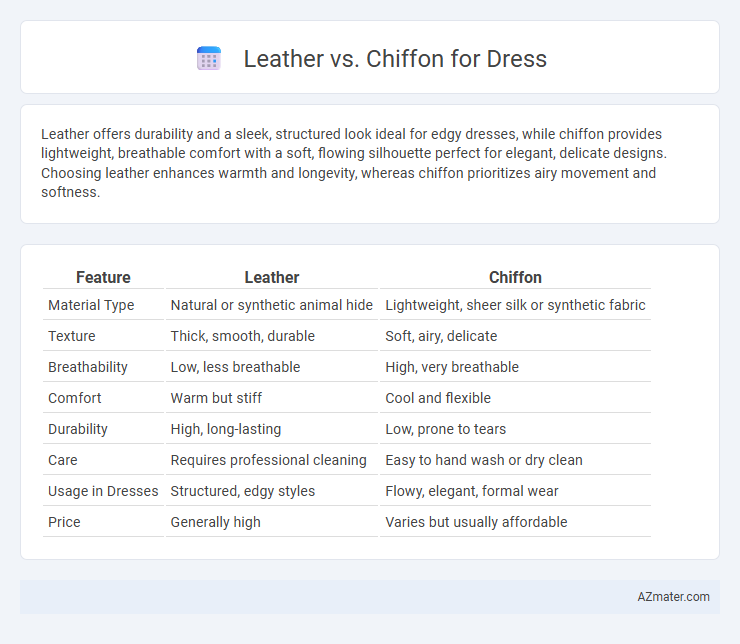Leather offers durability and a sleek, structured look ideal for edgy dresses, while chiffon provides lightweight, breathable comfort with a soft, flowing silhouette perfect for elegant, delicate designs. Choosing leather enhances warmth and longevity, whereas chiffon prioritizes airy movement and softness.
Table of Comparison
| Feature | Leather | Chiffon |
|---|---|---|
| Material Type | Natural or synthetic animal hide | Lightweight, sheer silk or synthetic fabric |
| Texture | Thick, smooth, durable | Soft, airy, delicate |
| Breathability | Low, less breathable | High, very breathable |
| Comfort | Warm but stiff | Cool and flexible |
| Durability | High, long-lasting | Low, prone to tears |
| Care | Requires professional cleaning | Easy to hand wash or dry clean |
| Usage in Dresses | Structured, edgy styles | Flowy, elegant, formal wear |
| Price | Generally high | Varies but usually affordable |
Introduction: Leather vs Chiffon Dresses
Leather dresses offer a bold, edgy aesthetic with durability and structure, making them ideal for statement looks and colder seasons. Chiffon dresses provide a lightweight, flowing, and breathable option, perfect for warm weather and elegant occasions. Choosing between leather and chiffon depends on the desired style, comfort level, and seasonality of the outfit.
Fabric Overview: Characteristics of Leather and Chiffon
Leather is a durable, heavy fabric known for its toughness, water resistance, and natural texture, often used in structured garments and outerwear. Chiffon is a lightweight, sheer, and breathable fabric made from silk or synthetic fibers, prized for its flowy, delicate drape and translucency in dresses. The contrasting characteristics--leather's rigidity and opacity versus chiffon's softness and transparency--define their respective roles in fashion design and garment construction.
Comfort and Wearability Comparison
Leather dresses offer durability and a structured fit but often lack breathability, leading to potential discomfort during extended wear or in warmer climates. Chiffon dresses provide superior comfort with their lightweight, breathable fabric that allows for better air circulation, making them ideal for prolonged wear and hot weather. While leather is favored for durability and a sleek appearance, chiffon excels in flexibility and comfort, especially in casual or formal settings requiring ease of movement.
Style Versatility: Outfits for Different Occasions
Leather dresses exude edgy sophistication, perfect for evening events, concerts, or chic casual outings, offering a bold statement with limited breathability. Chiffon dresses provide lightweight elegance, ideal for weddings, garden parties, and formal occasions, allowing fluid movement and comfort in warmer weather. Both materials cater to distinct style aesthetics, with leather embodying modern toughness and chiffon emphasizing delicate femininity, broadening outfit versatility across diverse settings.
Color Options and Patterns
Leather dresses typically come in solid, rich tones like black, brown, and deep red, offering a sleek, edgy look with minimal pattern options. Chiffon dresses, on the other hand, feature a wide array of vibrant colors and intricate patterns such as florals, polka dots, and abstract prints, providing a light, airy aesthetic. The versatility in chiffon allows for more playful and feminine designs compared to the bold, uniform appearance of leather.
Maintenance and Care Requirements
Leather dresses demand specialized maintenance, including regular conditioning to prevent drying and cracking, and professional cleaning to preserve texture and color. Chiffon dresses require gentle hand washing or dry cleaning to avoid fabric damage, along with careful handling to prevent snags and wrinkles. Proper storage for both materials is essential--leather should be kept in a cool, dry place away from direct sunlight, while chiffon benefits from hanging storage to maintain its delicate drape.
Pricing: Affordability and Value
Leather dresses typically command higher prices due to the cost of genuine hides and the craftsmanship involved in tanning and stitching, making them a luxury investment often exceeding $200. Chiffon dresses usually offer greater affordability, with prices ranging from $50 to $150, driven by the lower cost of synthetic or silk fibers and simpler manufacturing processes. Consumers seeking value balance durability and style; leather provides long-lasting wear and a premium look, while chiffon offers lightweight comfort and budget-friendly versatility.
Fashion Trends: Leather vs Chiffon Popularity
Leather and chiffon each dominate different fashion niches, with leather gaining popularity in edgy, urban, and statement-making dress styles, favored for its durability and bold aesthetic. Chiffon remains a top choice for lightweight, flowy dresses ideal for spring and summer, often linked to elegance and softness in fashion trends. Recent runway reports highlight a surge in hybrid designs combining leather's structure with chiffon's delicate texture, reflecting evolving trends that blend toughness with femininity.
Sustainability and Ethical Considerations
Leather production involves significant environmental impact due to livestock farming's high water usage and methane emissions, while ethical issues arise from animal welfare concerns and tanning chemical pollution. Chiffon, typically made from synthetic fibers like polyester, has lower direct animal impact but contributes to microplastic pollution and relies on non-renewable petroleum sources. Sustainable alternatives include vegan leather made from plant-based materials and biodegradable chiffons from natural fibers like silk or organic cotton, reducing ecological footprint and promoting ethical fashion choices.
Choosing the Right Fabric for Your Dress
Leather offers durability and a bold, structured look ideal for sophisticated or edgy dress styles, making it perfect for outerwear and evening wear. Chiffon provides a lightweight, airy texture with elegant draping, ideal for flowy, feminine dresses in warmer weather or formal occasions. Selecting between leather and chiffon depends on the desired, season-appropriate aesthetic, comfort needs, and event formality.

Infographic: Leather vs Chiffon for Dress
 azmater.com
azmater.com